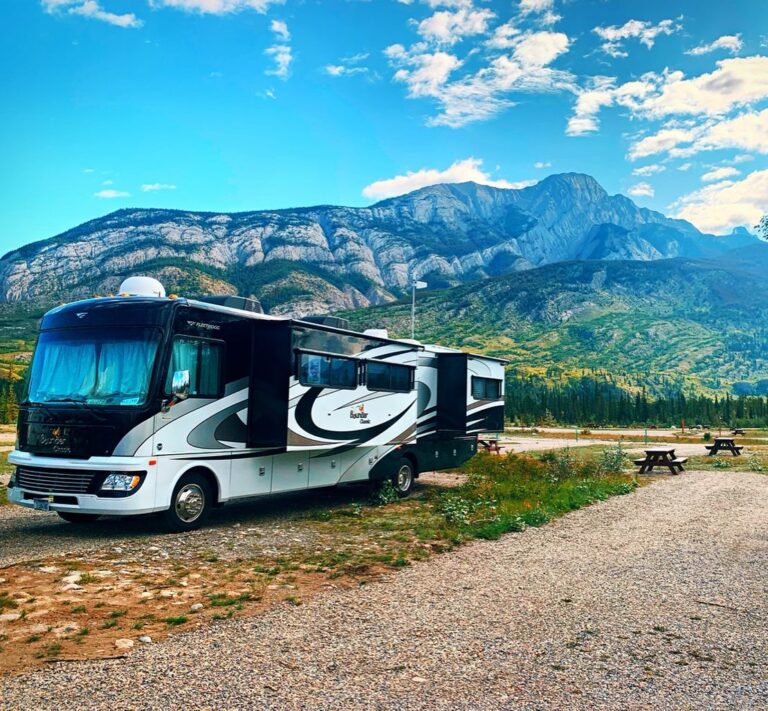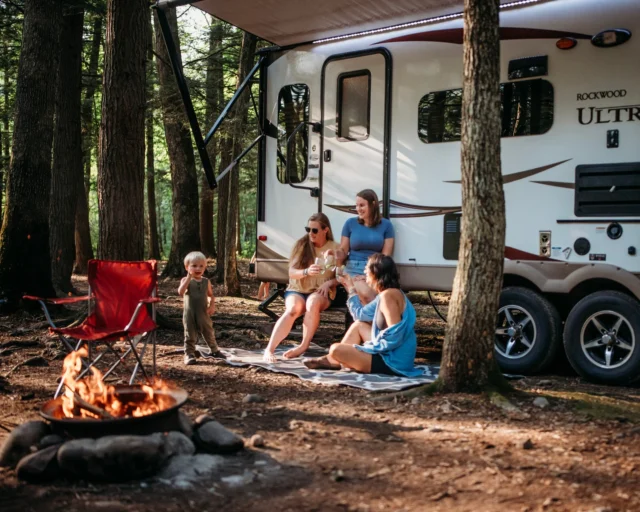
Suppose you plan on driving a motorhome, and are looking for more spacious options than a campervan. In that case, chances are you’ll be choosing between a Class A and Class C RV. Let us guide you through these options to find you the perfect home away from home.
In-depth Understanding of Class A and Class C RVs
When embarking on an RV road trip, the choice between a Class A and a Class C RV can significantly influence your travel experience. Class A RVs are often likened to luxurious homes on wheels, offering expansive living spaces and high-end amenities.
Class A RVs, ranging from 25 to 45 feet, prioritize comfort and style, while Class C RVs, spanning 20 to 31 feet and built on a truck chassis with an over-cab sleeping area, offer a balance of comfort and maneuverability.
| Feature | Class A | Class C |
| Design | Bus-like, flat fronts, large windshields | Truck-like, with a cab overhang |
| Size | Typically 30-40 feet | Usually 20-30 feet |
| Sleeping Capacity | Often sleeps up to 8 people | Typically accommodates 4-6 people |
| Amenities | High-end (e.g., full-size refrigerators, luxury interiors) | Moderate (e.g., compact appliances) |
| Maneuverability | Challenging in tight spaces | Easier in narrow campsites |
| Fuel Efficiency | Lower due to size and weight | Generally better than Class A |
Despite their size, many choose Class A RVs for their expansive living space and luxury amenities, resembling a rolling home. Conversely, those valuing fuel efficiency, ease of driving, and affordability may prefer Class C RVs.
Luxurious Living with Class A Motorhomes
When considering an RV road trip, Class A motorhomes stand out for their luxury and spaciousness, offering nearly all the comforts of a traditional home. Designed for ultimate comfort, these RVs feature expansive interiors with upscale amenities like king-sized beds, residential-style kitchens, full bathrooms, and washer-dryers, making them ideal for full-time RVers or large families. Available in sizes from 25 to over 40 feet, Class A RVs accommodate both couples and families with extensive space and storage. However, their luxury comes at a price—these RVs are typically the most expensive, with new models costing several hundred thousand dollars and consuming more fuel. They can also be challenging to navigate in tight spaces, but their benefits often outweigh the drawbacks for those planning extensive travel or full-time living.
A comparison of three popular Class A models.
| Model | Length (feet) | Key Features | Price Range |
| Thor WindSport 34J | 35.5 | Outdoor kitchen, king bed | $140,000 – $160,000 |
| Winnebago Adventurer 36Z | 36 | Three slide-outs, bath-and-a-half layout | $170,000 – $200,000 |
| Tiffin Allegro Bus 45 OPP | 45 | Four slide-outs, walk-in closet | $450,000 – $700,000 |
Practicality Meets Comfort in Class C Motorhomes
Class C motorhomes are ideal for newcomers or medium-sized families, offering a blend of comfort and practicality. With features like over-the-cab bunk beds, they provide cozy sleeping spaces while remaining manageable in size for city roads and campgrounds. Class C RVs are also more budget-friendly than Class A models, with lower purchase, rental, maintenance, and fuel costs. Driving a Class C feels similar to driving a truck, making it less daunting than a larger Class A.
Key Advantages of Choosing a Class C Motorhome for Your Road Trip:
- Cost-effectiveness: generally lower purchase and maintenance costs.
- Ease of Driving: This is more akin to driving a truck than a bus, appealing to those who prefer a more familiar driving experience.
- Efficient Use of Space: Over-the-cab beds maximize living space without sacrificing comfort.
- Suitability for Various Trip Types: Perfect for weekend getaways or extended travels due to its versatile setup.
- Family-Friendly Features: It often comes with amenities that cater well to family needs, such as multiple sleeping areas and compact yet fully equipped kitchens.
For your next adventure on a scenic highway, a Class C motorhome makes for an excellent travel companion for national park roads and festival sites.
Behind the Wheel: Driving Class A vs. Class C
Navigating the highways in an RV epitomizes the freedom of the open road. For those new to RV travel, understanding the differences between driving a Class A and a Class C RV is crucial. Class A RVs, similar to maneuvering a bus, offer a commanding road view but require confidence due to their size, especially in tight spots. In contrast, Class C RVs, akin to driving a truck, provide better fuel efficiency and easier handling, making them less intimidating, particularly in urban environments or narrow campgrounds.
Top 3 Driving Tips for New Class A and Class C Owners:
1. Get Comfortable with Dimensions: Before hitting the road, spend time understanding the size of your RV. Practice turning and parking in a safe area.
2. Check Blind Spots: Both RV types have significant blind spots. Use mirrors effectively and consider installing blind spot cameras.
3. Plan Your Route: Avoid surprises by planning ahead, including checking overhead clearances and road suitability for larger vehicles.
Choosing between the luxurious expanse of a Class A or the agile convenience of a Class C RV presents unique challenges, and understanding these nuances ensures a more enjoyable and well-prepared journey.
Class A vs Class C FAQs
- What is the average fuel consumption of a Class A vs. a Class C RV? Class A RVs, due to their larger size and weight, consume more fuel, averaging 7-10 miles per gallon, while Class C RVs offer better fuel efficiency at 10-15 miles per gallon. This difference can significantly impact the overall cost of your RV road trip.
- What are some luxury amenities typically found in a Class A RV? Class A motorhomes are renowned for their expansive luxury accommodations. These might include full-size residential refrigerators, washer and dryer units, multiple flat-screen TVs, and even fireplaces. Such amenities make Class A ideal for those seeking a high-end living experience on wheels.
- Why is a shorter wheelbase beneficial when choosing a Class C RV? Class C RVs, with their shorter wheelbase, offer better maneuverability and stability, making them easier to handle in tight spaces like narrow campgrounds or city traffic—ideal for those new to driving large vehicles.
- How does maintenance cost differ between Class A and Class C motorhomes? Class A RVs generally have higher maintenance costs due to their complexity and upscale systems, while Class C motorhomes, with their simpler design, usually incur lower maintenance expenses.






